Denon AVR-S670H
Product Name: Denon AVR-S670H
Product Description: 5.2 CH 8K AV Receiver
-
Design - 9/10
9/10
-
Audio Quality - 8.8/10
8.8/10
-
Inputs / Ports - 9/10
9/10
-
OS, Apps and Features - 9/10
9/10
-
Price / Quality - 8.9/10
8.9/10
Summary
Reviewed at $549.00
Pros
- Immersive sound
- Full 40Gbps HDMI 2.1 ports
- A lot of online and offline features
- Affordable price
Cons
- Almost the same as the AVR-S660H
- No front HDMI input
- Composite ports completely taken out
- No backlight remote
Cheapest Places to Buy :
*We are a reader-supported website. When you buy through links on our site, we may earn a small affiliate commission at no extra cost to you. Home Media Entertainment does not accept money for reviews.*
Introduction
Although Denon refreshed big part of their AV receivers product lineup last year there were still a few models that were left unattended. With only one new 2022 model in the S-series, namely the AVR-S970H, there were two notable omissions. And it seems that Denon decided to refresh them this year. As such, in our Denon AVR-S670H review today we will be testing this new low cost 5.2 channels unit, check its features and compare it with its 2021 predecessor, the AVR-S660H.

The S-series is the more affordable series in Denon’s lineup. It usually consists of three models, and the AVR-S670H is the most affordable multichannel AV receiver Denon is offering today. Both the AVR-S670H and the AVR-S770H, which we plan to review soon, were released in the 2nd half of 2023. This way Denon brought the entire S-series up to the latest Sx70H naming scheme.
But let’s see real quick all the specs of this new AV receiver. The Denon AVR-S670H is a 5.2 channels system with 75 watts of power (for 2 channels driven). It supports Dolby TrueHD, DTS-HD Master Audio and various other up-mixing and virtual technologies. It also comes with plenty of extras. Some of them include High Resolution Audio, offline and online streaming and 3 HDMI 2.1 ports.
Dolby Atmos may be all the rage lately. But this doesn’t mean that there is no interest for non Atmos systems. After all, not everyone can have additional Atmos speakers in their house. And a simple 5.1 system is more than enough to enjoy good cinematic surround sound. With this in mind, does the new AVR-S670H fit the bill? Let’s put it to the test to find out.
Design
Looks and Dimensions
Design wise, the S670H is completely the same as the S660H, both in terms of size and design. It seems that the minor changes these two units have allow for the use of the exact same shell.
As such the unit measures 17.1″ x 13.3″ x 8.5″ (434 x 339 x 215 mm) with the antennas in vertical position. As usual, you can slightly minimize its height to 6″ (151 mm) if you turn them horizontally without any loss of wireless quality. The size of the receiver is just about what you should expect from its category, so no real surprises here.
Front Layout
In real Denon fashion the outer shell is featuring straight lines and sharp corners. This is your typical black box receiver after all that sounds much better than it looks. The front features a brushed metal texture with an exact shame layout as most previous releases.
This means a big central display showing all functions. With two big circular knobs at each side for volume on the right and source selection on the left. Under the source selection knob we find the power button. While a thin line under the central display houses 10 function buttons. These are for Tuner controls, Dimmer, Status, Info and Mode along with two groups of four circular buttons underneath. One group being the quick selection buttons and the other the sound modes.
Under these buttons, as usual, we get the front ports. Here we find the headphones jack and setup microphone port on the left. And a single USB port on the right that you can use to stream audio from a USB based external storage like a flash drive. No HDMI input here unfortunately.

Internal Hardware
Next we will take a look at the insides of the unit.
The receiver features discrete high-current amplifiers on all channels with low-impedance drive capability. It uses a 32-bit Texas Instruments PCM5102A DAC for high resolution audio decoding up to 192 kHz / 24-bit. This provides low distortion and the widest possible dynamic range.
This is the exact same DAC we saw Denon use in their new AVR-X1800H. It seems this is the DAC they decided to use in many of their lower tier models lately.
Remote
As for the remote, the one we found with the AVR-S670H is codenamed RC-1258. The remote is very similar to the RC-1243 remote the AVR-S660H is using, as there are some very minor changes between them.
The remote comes with all the input buttons at the top along with the HEOS and Bluetooth functions. Navigation buttons are in the middle along with channel and volume controls. While playback, quick selection and sound mode buttons are as usual at the bottom.
The remote in general is a big one. While the buttons have a relatively small size and we would like them a little bigger to be easier to the touch. At least the long distance between them minimizes the risk of a wrong command. Which can be a regular phenomenon in a dark environment since the remote lacks any kind of backlight functionality. Its construction is good and feels pretty solid with a nice texture on top to make it look a little bit more premium.
The changes we get in this year’s version is that Denon took out the Eco button. And they also changed the sound mode buttons at the bottom from colored ones to single white color. But that’s about it. Everything else is exactly the same.

Audio Specifications
The receiver does not support the latest Dolby Atmos and DTS:X. Instead it has to settle with the older Dolby TrueHD and DTS-HD Master Audio channel based formats. This also affects the kind of up-mixing and virtual technology features included.
Virtual Sound & Up-mixers
When it comes to up-mixing tech the receiver uses Dolby Pro Logic ll and DTS Neo:6. What these up-mixing tech are doing is to up-convert stereo and legacy mixes in order to make use of all the speakers you have in your setup.
As for virtual tech the Matrix sound mode is capable of creating sounds that originate from virtual created speakers around your room where there are no physical speakers present.
This virtual tech obviously is not as good or accurate as having real physical speakers. And is very much room dependent. Also the sound usually can be heard very over-processed something we were never very fond of. But obviously some people may like it so it is never bad to include such technologies.
Internal Amplification
The AVR-S670H comes with 5 channels of built-in amplification. Each channel is capable of outputting 75 watts of power (8 ohms, 20 Hz – 20 kHz, THD 0.08%, 2ch drive). Which is enough for most small to mid sized rooms. Keep in mind that this is only for 2 channels driven. This means that when all 5 channels are active this number goes down considerably. The receiver cannot process more channels so this is the maximum it can do.
It can also support up to two subwoofers which is the standard nowadays. But surely not the best as many new units can support up to 4 subwoofers now. But two is more than enough for such a unit that you are mostly going to use in basic setups.
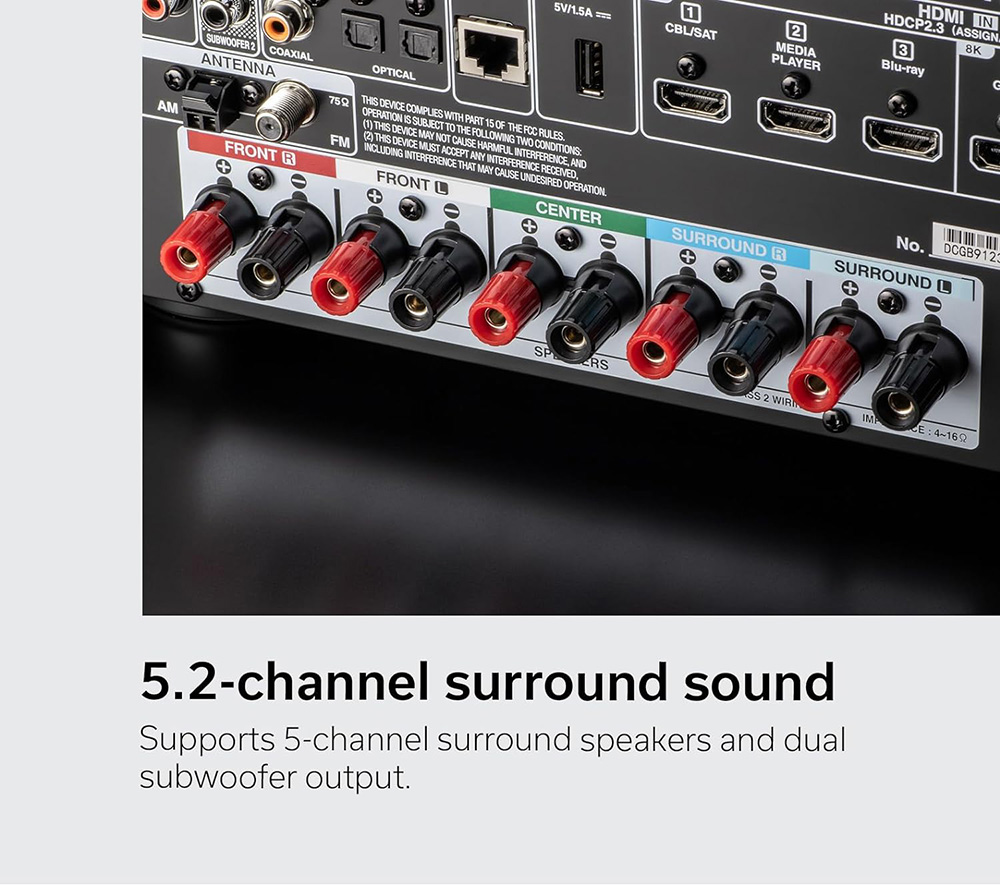
Movies Testing
Since there is no Dolby Atmos to try out in this unit we decided to test Interstellar in 4K UHD which features an amazing DTS-HD Master Audio mix.
Front Soundstage
The film may lack the latest in object oriented audio. But Christopher Nolan knows how to create a bombastic and fully immersive atmosphere even with channel based formats that he is still such a fan of.
The Denon AV receiver masterfully redefined the front soundstage showcasing an unparalleled level of sonic precision. As the film unfolded, the receiver delicately unveiled the layers of the soundtrack. Allowing the subtle nuances of each instrument to shine.
The clarity in the midrange frequencies ensured that every whisper of dialogue and intricacy in Hans Zimmer’s composition is faithfully reproduced. Furthermore, the receiver’s dynamic range breathed life into the audio. Capturing the softest whispers and the thunderous roars with equal finesse.
One notable standout is the receiver’s handling of spatial imaging within the front soundstage. The pinpoint accuracy of sound placement created a truly holographic effect. This enables the listener to perceive the exact location of each sound source. Whether it’s the haunting echoes of a distant spacecraft or the sweeping orchestral crescendos, the Denon AVR-S670H crafted a meticulously detailed sonic panorama that heightens the emotional resonance of the film.
The front soundstage, under the receiver’s influence, truly shined. Elevating the overall cinematic experience to unprecedented levels of realism.

Surround Performance
In the realm of surround sound, the Denon AV receiver again got top grades. It flawlessly navigated the intricate spatial cues, enveloping the listener in a three-dimensional audio environment.
The precision of the receiver’s surround processing ensured that every rustle of leaves or distant spacecraft engine reverberated authentically throughout the room. This heightened sense of spatial awareness not only elevated the movie-watching experience. But also underscored the receiver’s prowess in delivering an encompassing and realistic surround performance.
Bass
When it comes to the low-frequency prowess, the Denon AV receiver proves its mettle in handling the intense bass sections of such a blockbuster. The gravitational pull of deep space and the rumble of rocket engines were rendered with a visceral impact, thanks to the receiver’s robust low-frequency output.
Whether it’s the heart-pounding moments of space-time distortion or the powerful crescendos in the soundtrack, the AVR-S670H delivered a commanding bass response that added a palpable intensity to the movie. It stroke a perfect balance, providing a punchy and controlled bass. But without overwhelming the finer details of the audio spectrum.
Music Testing
In terms of music the AVR-S670H naturally comes with an extensive list of supported files and codecs. The usual low quality ones are there like MP3, WMA and AAC. But we also get High Resolution Audio support in the likes of FLAC, WAV, Apple Lossless and DSD.
For this test we used our trusted Zidoo Z9X media player in order to stream some music files to the receiver.
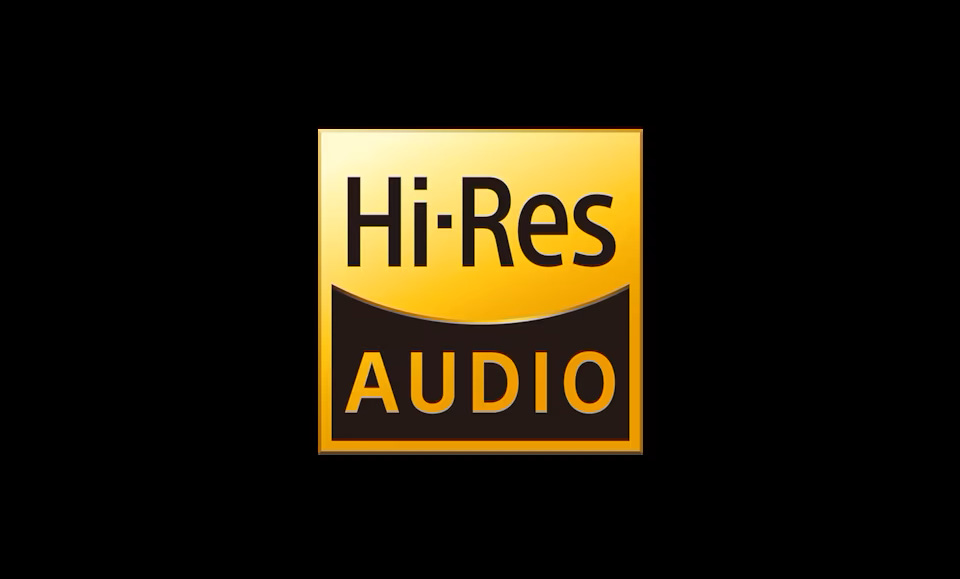
Beyond its prowess in home theater, this AV receiver demonstrated an exceptional aptitude for handling music with finesse and depth. When we turned our attention to a diverse playlist, the receiver exhibited a remarkable balance, rendering every musical genre with precision and clarity.
Whether it was the intricate details of a classical symphony or the pulsating beats of contemporary electronic tracks, the AV receiver showcased a nuanced and faithful reproduction of the original recording.
The receiver’s commitment to high-fidelity audio was evident in its ability to unravel the layers of complex compositions. Instruments were distinct and well-defined, occupying their rightful space in the sonic landscape.
The midrange frequencies carried the soulful warmth of vocals, and the resonance of string instruments, while the high frequencies sparkled with crystalline clarity. Even in moments of intense musical crescendos, the AVR-S670H maintained control, preventing very obvious distortion and preserving the integrity of the sound.
What impressed us most was the dynamic range the receiver brought to music playback. From the gentlest notes to the thunderous peaks, the transitions were seamless. Capturing the ebb and flow of each musical piece with captivating authenticity.
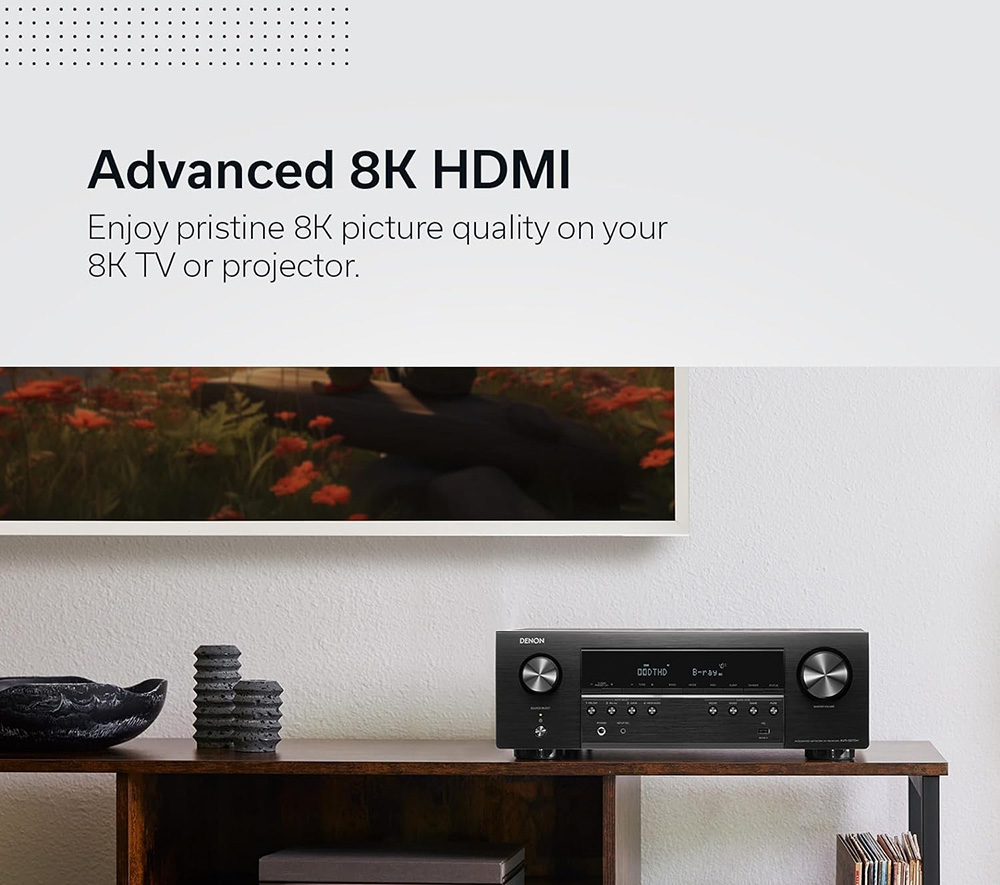
Performance Conclusion
Whether you’re an avid audiophile, dedicated cinephile or simply someone who appreciates good music, this Denon AV receiver proves to be a versatile companion. It can offer an immersive and gratifying experience that extends beyond the realm of home theaters. And this is something that many users will greatly appreciate.
Connectivity
Ports Analysis and Layout
Next we will take a look at all the connections available in the unit. Again, the S670H has many similarities to the S660H, but also a couple of glaring differences.
But before we talk about them, let’s see what is actually there.
We already mentioned above about the frontal ports that include the Headphones jack, the setup microphone port and the USB port.
At the back of the unit we find the 5 speaker terminals placed in a straight line which helps a lot with cable management. The terminals are the usual quality we have seen from Denon so all is good here, with good quality plastic caps. Keep in mind that each terminal has its own amplification.
At the top we find 6 HDMI inputs and 1 HDMI output. Three of them are HDMI 2.1 while the other three are the older HDMI 2.0.
As for the rest of the connections we get 2 optical and 1 coaxial digital inputs, 1 Ethernet port, 2 subwoofer pre-outs, 2 analogue audio inputs and one more dedicated for phono, a 2nd USB for power distribution and the usual FM/AM antenna inputs along with the WiFi/Bluetooth connectors.
The obvious change in the S670H is that Denon decided to take out the composite ports found in the S660H completely. In return they added the 2nd USB port for power distribution.
What Denon did with the AVR-S670H is exactly the same we saw with the AVR-X1800H. They are phasing out all analog ports from all new products. So if this is important to you then we suggest you get one of the previous models as long as stock is still available.
HDMI Specifications
The new S670H comes with three HDMI 2.0 ports capable of 18Gbps and three more HDMI 2.1 ports that support all the old and new exciting technologies available today.
These include 8K/60Hz and 4K/120Hz video passthrough, 40Gbps bandwidth, 4:4:4 Pure Color sub sampling, HDR10, HDR10+, Dolby Vision, Hybrid Log-Gamma (HLG), Dynamic HDR, 3D, BT.2020 pass-through, Variable Refresh Rate (VRR), Auto Low Latency Mode (ALLM) and Quick Frame Transport (QFT).
Just to make things clear the S670H is obviously using a new, bug-free HDMI 2.1 chip. All the 2020 AV receivers that featured HDMI 2.1 ports came with a bugged Panasonic chip that wouldn’t allow it to pass certain signals. Like 4K/120Hz RGB signals from the Xbox series X for example, as it would result in a black screen.
The AVR-S670H on the other hand seems to be using an updated version of this HDMI 2.1 chip which allows up to 40Gbps of bandwidth in three of its HDMI ports and this includes all the signals with a 4K@120Hz configuration including Xbox Series X.
In order to confirm that everything works fine we connected both our PS5 and Xbox Series X to one of the HDMI 2.1 ports of the Denon AV receiver. In both cases we were able to get a trouble free 4K@120Hz signal.
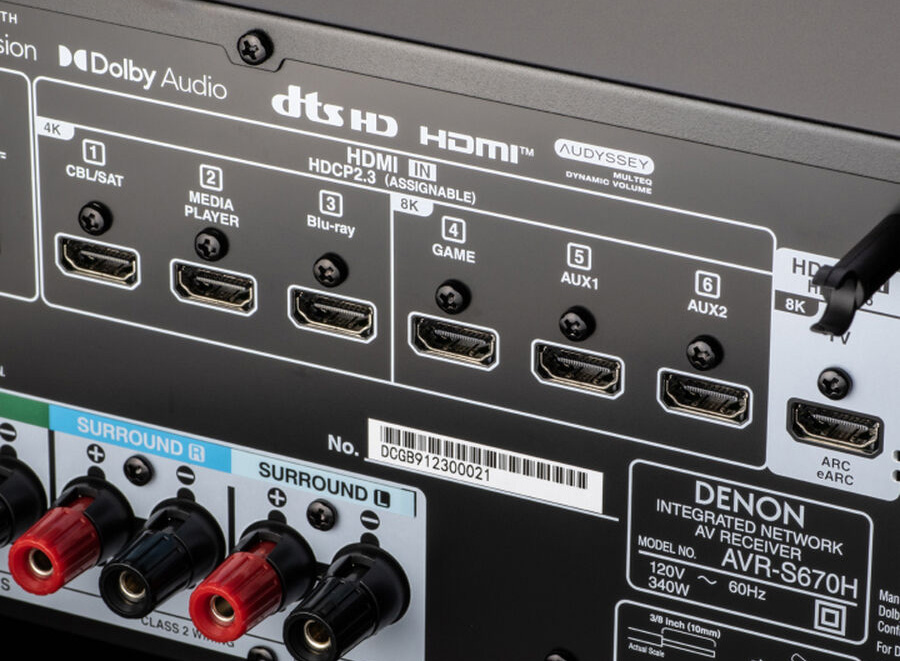
Wireless Capabilities
As for the unit’s wireless capabilities we get built-in WiFi (IEEE 802.11a/b/g/n/ac) which can connect both in 2.4GHz and 5 GHz networks. We also get Bluetooth support and it seems that Denon decided to upgrade its module as it is now v5.0 instead of the v4.2 most Denon AV receivers had until now. Unfortunately this still supports only the basic SBC codec.
OS, Apps and Features
Next we will take a look at what extras and features the receiver comes with. Looking at the entire feature list available we do not find any meaningful differences compared to the S660H. So let’s go over everything that is available.
Audio Calibration System
And we will start with the audio calibration system. Denon is using the Audyssey system. And as with all manufacturers they scale it accordingly to meet the price and performance standards of each of their models.
Audyssey MultEQ
The AVR-S670H is using the most basic version of it. The Audyssey MultEQ is a step lower than the more advanced XT version you can get in the X1800H. In comparison this one features lower resolution filters which can result in less accuracy.
The Audyssey MultEQ comes with the Dynamic Volume and Dynamic EQ features. Dynamic EQ is a feature that is responsible for keeping the clarity and dynamic levels of audio even when you like to watch at low volume, like for night viewings for example.
Dynamic Volume on the other hand is capable of balancing sudden changes and spikes in volume that could appear when there are sudden changes from TV broadcasting to commercials.
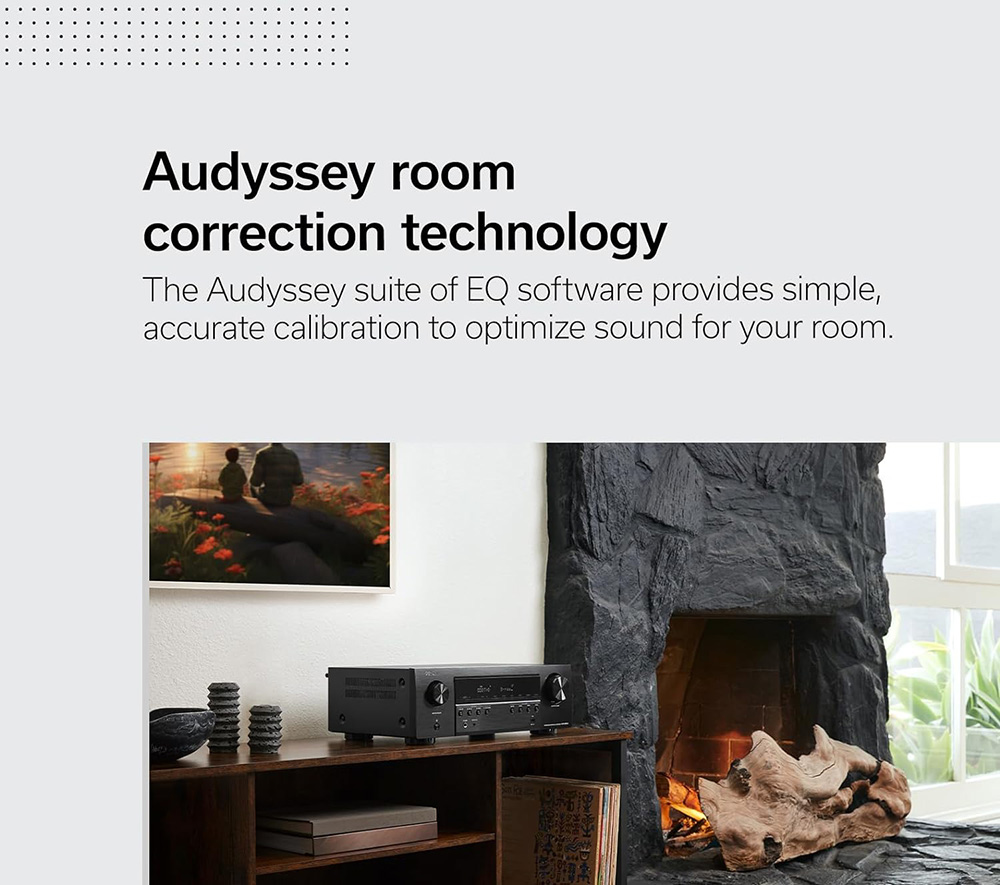
Audyssey calibration
Going through the Audyssey calibration with the built-in wizard is as easy as it gets. As you just follow the simple instructions on screen to completion. Keep in mind that the S670H is one of AV receivers that doesn’t support the Audyssey MultEQ Editor app and so you cannot do more advanced calibration of the system. But honestly for such a low cost model we wouldn’t expect otherwise.
After all the built-in system is more than enough for most casual users as it offers almost anything you need to make very good and precise adjustments to your system.
Denon AVR Remote App
But Denon provides another app for this AV receiver and this one comes completely free. The Denon AVR Remote app lets you control the unit with your mobile device through a nice visual interface. If you are tired of the included remote this is a nice, and most important, free alternative. The app is available for both Android and iOS devices so we suggest you give it a try to see if you like it.
User Experience
And since we mentioned the visual interface we have to talk about the updated GUI that all Denon AV receivers have now. Denon changed the UI last year in some of their new models and it seems this will be the one used for all new releases.
For some years now we were complaining about how old style and outdated the UI of the Denon AV receivers looked. It was as though it belonged in the early 2000s with its simple menus and 480p resolution.
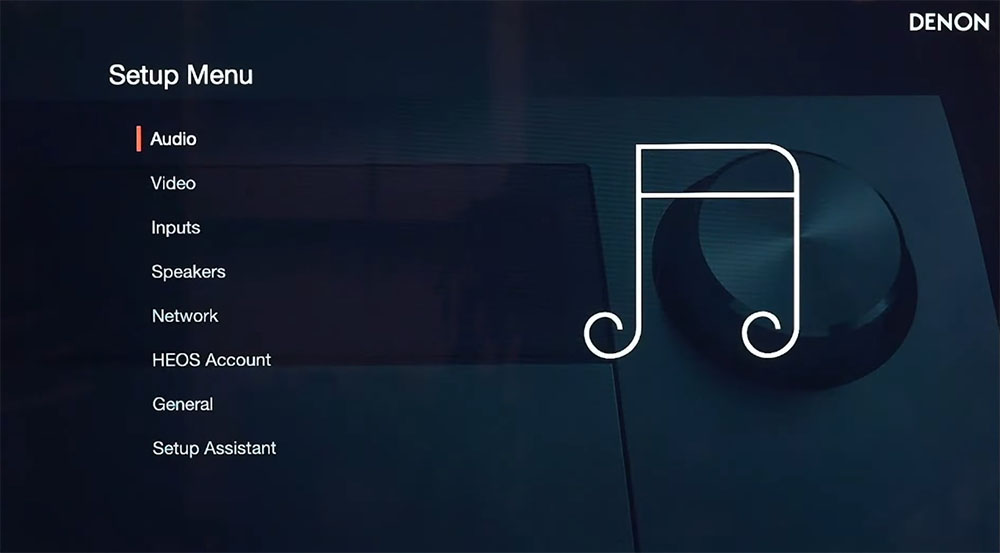
The new menus are not all that different in terms of structure and layout. You still get the same list of features in a similar way to the old UI. But they bumped the resolution up to 1080p and made it look graphically more pleasing to the eye. Now it feels like it is something newer. And although it may not be as fancy as what smart TVs have, it is far better than what we were getting till now.
But if you like a more hands free experience, the AVR-S670H supports all known voice control platforms. As such there is support for both most known ones with Amazon Alexa and Google Assistant. But there is also support for Apple’s Siri through the Airplay 2 app and the advanced automation system Josh.ai making this receiver complete in every way.
Lastly there is HDMI-CEC. This one lets you use the TV remote to control the AV receiver, if the TV also supports this. Obviously this feature lets you use only the most basic functions of the receiver but for everyday use it can be a very time saving feature. And you can reduce the amount of remotes you have to use every time.
Online Streaming
In terms of streaming you get the usual we see in all Denon models.
There is both HEOS and Airplay 2 you can use to stream music online from one of the available online streaming services. These are TuneIn Internet Radio, Spotify, Amazon Prime Music, Tidal, Deezer and more.
All of them are available for downloading from their appropriate stores for use with your mobile device.
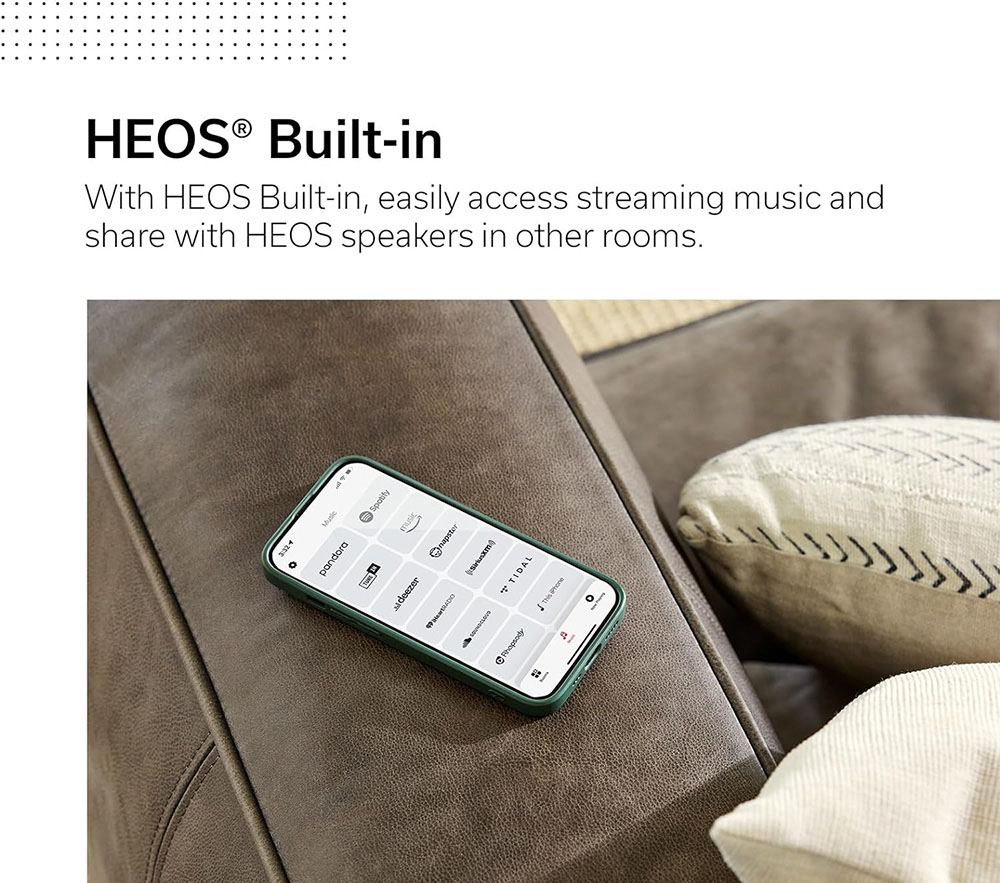
Offline Streaming
As for offline streaming, there are also plenty of options for you. You can stream audio from a network drive or NAS server if it happens you to have one connected to your local network.
Also with the included frontal USB port you can stream music through some connected external storage or flash drive. Lastly if you prefer a more wireless way of streaming your music there is Bluetooth available for connecting with your mobile device. If you use Apple devices then Airplay 2 can also be used to stream music wireless through it.
And since we mentioned Bluetooth, another function that is included in the S670H is its ability to output sound from both the main speakers and through a Bluetooth connection. The AV receiver is capable of streaming audio to Bluetooth enabled headphones for a completely silent house experience. Or it can also output sound from both its speaker terminals and to a Bluetooth headset. This can be particularly practical in case there is a member in the family that is hearing impaired.
But keep in mind that this can be used only for music and not for movies. And this happens because the Bluetooth transmitter of the AV receiver is using the SBC codec and not some more advanced variant meant for such use, like aptX Low Latency. As a result there is bound to be an audio delay due to the Bluetooth transmission speed, making this feature ideal only for music use.
Multi-Zones Capabilities
You can also create your own multi-room environment with the use of appropriate wireless speakers. Unfortunately the wired options of the AVR-S670H are limited as there are no additional Zone 2 ports to use. So you cannot run wires to another set of speakers placed in another room.

Various Other Features
There are plenty more extras and features Denon includes in all their releases. So let’s go over them real quick.
The receiver supports video upscaling to 8K resolution. But the obvious limitation here is that the S670H can do that only through its HDMI ports as all analog ports are taken out. We also get an ECO mode that can regulate the receiver’s power usage as well as being “Roon Tested” certified.
For this last one there seems to be a bit of confusion. As there are two types of certifications. Roon Ready and Roon Tested. The AVR-S670H, as with all Denon AV receivers, is Roon Tested.
This means that while Roon will work on this unit, you will not get the highest quality possible. So for example if you use Airplay, audio quality is limited to 16 Bit/44.1kHz. Keep that in mind in case Roon is specifically important to you but also want your files to be streamed in their original quality.
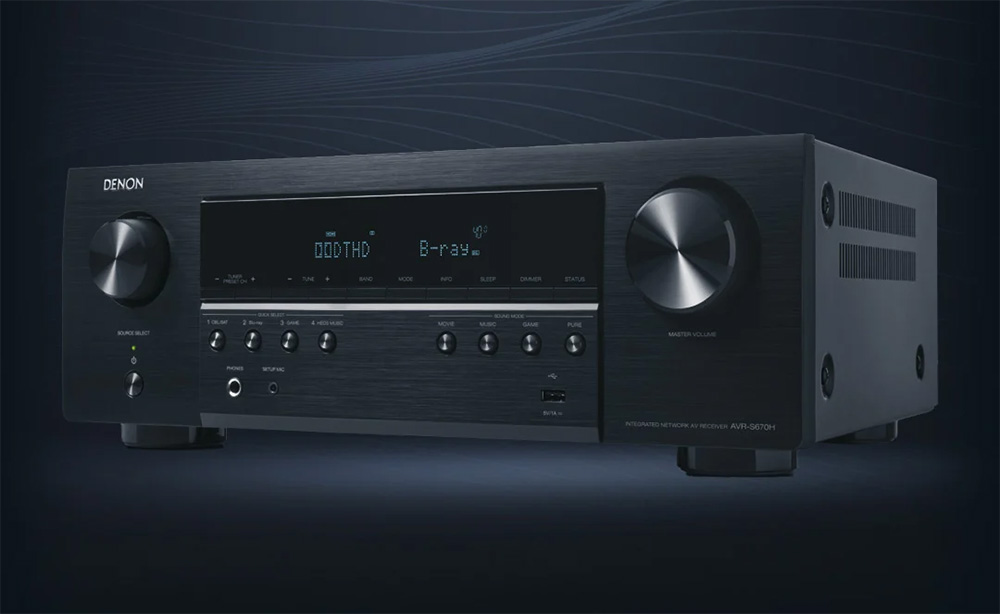
Compared to Other AV Receivers
Obviously you are wondering if there are any differences between the 2021 AVR-S660H and the new AVR-S670H. Well, the new unit has an additional USB port for power distribution instead of the composite ports that are taken out, it comes with an updated GUI, a slightly better Bluetooth v5.0 module and a slightly altered remote. Everything else is exactly the same.
There are a couple more options you can look at in the 5.2 channels market. The first one is the Yamaha RX-V4A which is slightly cheaper than the Denon but comes with almost the same features.
And then there is the Anthem MRX 540 which packs far more features as it also supports Dolby Atmos, DTS:X and IMAX Enhanced. It can also be expanded to a 7.2 channels system with an external amp. The downside is the unreasonably high price as it costs almost 3 times the price of the Denon.
Final Thoughts
Not everyone has the luxury to add a huge amount of speakers all over the house. And a simple 5.1 channels setup is enough to enjoy basic but still fully immersive cinematic magic. And the Denon AVR-S670H is this kind of AV receiver. While it will not impress you with its extensive features list and power capabilities, it can still deliver the goods.
For a basic 5.1 channels system there is nothing more that you will need. The Denon has the power, surround capabilities and basic features to throw you in the action and close you in a 360 degrees immersion bubble without making your wallet bleed.
As for its downsides, the AV receiver is practically the same as the S660H. The changes Denon did are very few in our opinion to justify a new product. Denon decided to take out all composite ports and you get practically nothing in return. There is no front HDMI which should be standard in our opinion. And unfortunately no backlight in the remote will require a huge effort to use it in a completely dark environment.
We reached the end of our Denon AVR-S670H review and we can admit that the unit left us with really good impressions. Yes, there are no major differences with its predecessor but if you are looking for a good performing 5.1 AV receiver in order to create a basic surround setup then you should look no further. Denon should definitely be one of your first choices here.
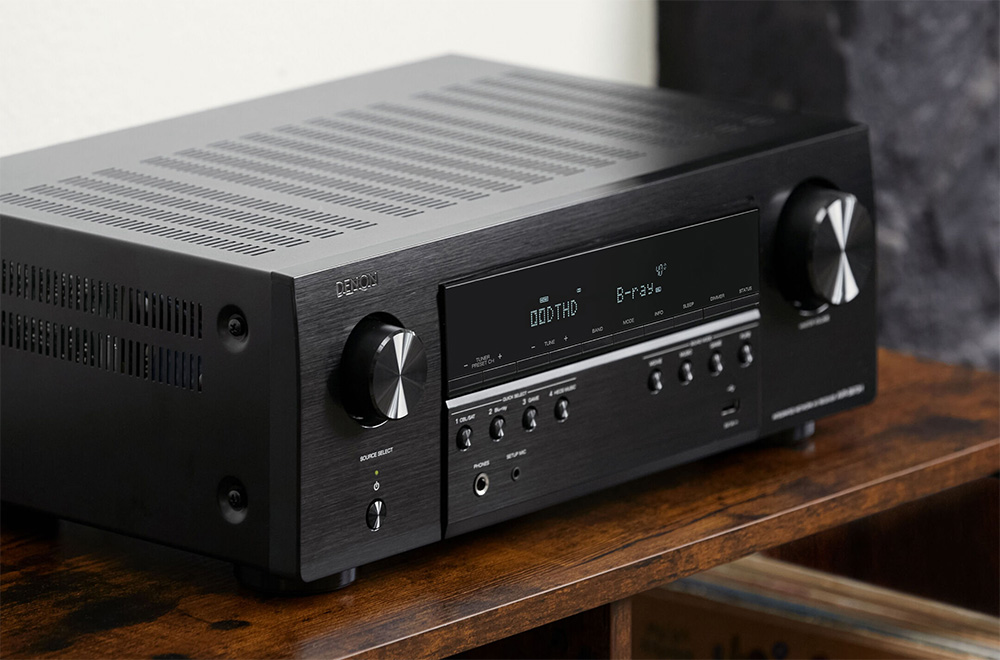
For more reviews you can check our dedicated 5 channels 8K AV Receiver reviews list or even look at our Product Reviews Table where you can find the brand and specific product you are looking for.
Cheapest Places to Buy :
*We are a reader-supported website. When you buy through links on our site, we may earn a small affiliate commission at no extra cost to you. Home Media Entertainment does not accept money for reviews.*







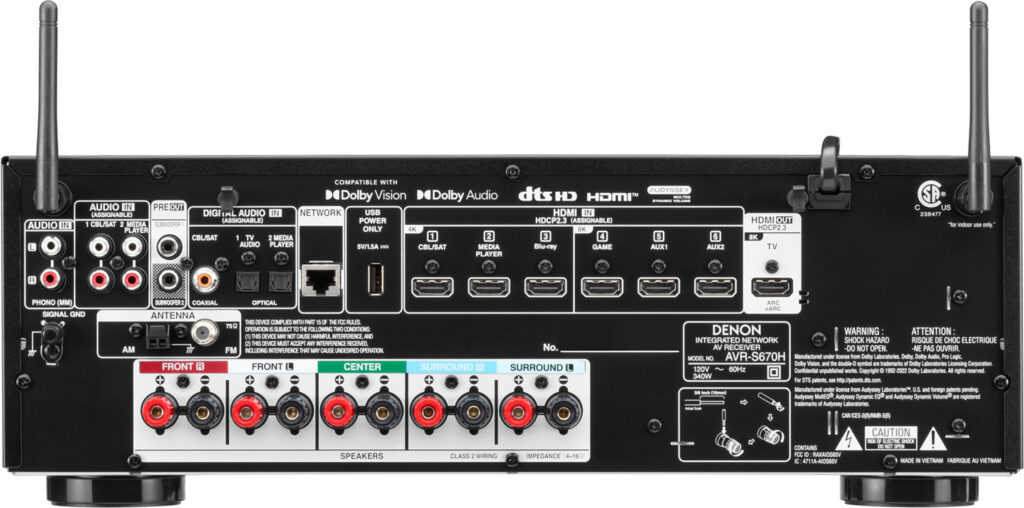
Great review! It’s awesome to see such a detailed breakdown of the Denon AVR-S670H. I’m particularly interested in the audio performance and your experience with it during movie and music testing. It seems like it handles both with finesse, providing a captivating and immersive experience.
Did you notice any significant differences in the performance compared to its predecessor, the AVR-S660H, besides the additional USB port and updated GUI? Also, how user-friendly did you find the Audyssey calibration system, especially considering it’s the basic version.
Thanks for sharing your insights! Looking forward to your response.
Hey Ryan. As I mentioned in the review, both the S660H and S670H are exactly the same in terms of performance. As for the calibration system, this is as simple as it gets. You just follow the on-screen instructions which are clear and easy to comprehend.
Thank you very much, i was waiting this review, since i was looking at the 660. Seems not so different from the 670. 75 Watts Channel can drive well the kef q350? Is It good in stereo, in pure direct, or i should look something better? Really nice work Stratos.. I would like to see a review of the Dune HD Ultra Vision 4K.. maybe one day
Hello Santo. Yes, the S670H is practically the same as the S660H. And it shouldn’t have any problem driving the KEF Q350 as their minimum requirements is just 15 watts.
As for the Dune HD Ultra Vision 4K unfortunately Dune HD does not give samples of products that are close to end of life. So unless I can find a unit through other means, which I will try to, I will only be able to review some of their newer releases only.
I always loved Denon. But damn they do need to refresh their design a bit. They look so old already. Marantz and Yamaha already did this, why don’t they do it also? A lot of recycling from Denon lately. And all I see is prices going up without offering anything new in returning. They even took out the composite ports! I really don’t know what they are thinking.
Hey there. Well, Denon is not the only company doing this. I really fail to understand why they keep adding new products when there are hardly any changes in them. I do see why they took out the composite ports, but is this enough for a new product that is basically exactly the same as the S660H? I just don’t see it.
Can someone please recommend speaker system for AVR-S670H?
I’m looking at a sub $ 1000 budget.. Virtually no one talks about the right pairings for receivers ..
Hello Sam. Can you please give me some more details so I can help you? Obviously you are looking for a 5.1 channels setup, right? For what space are we talking about? Are you looking for floorstanders or bookshelves? Are there any specific brands available to your area? The more information you can give me the better.